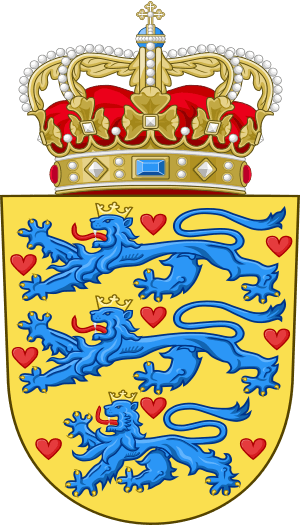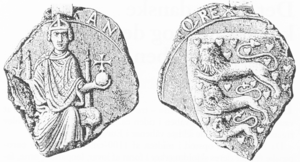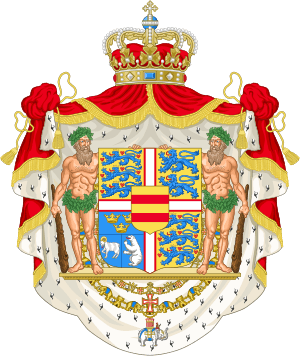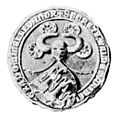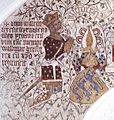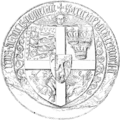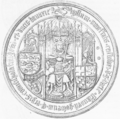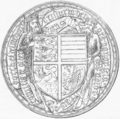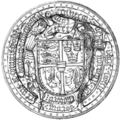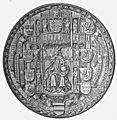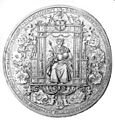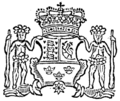Coat of Arms of Denmark facts for kids
The coat of arms of Denmark shows three crowned blue lions with nine red hearts. They are all on a golden shield. This special design has been used for a very long time.
The oldest known example of Denmark's coat of arms comes from the seal of King Canute VI. This seal was made around the year 1190.
Contents
What is the Danish Coat of Arms?
The main coat of arms for Denmark is often called the National Coat of Arms. It is used by the Danish government. This is the one with the three blue lions and nine red hearts.
For many years, Denmark also had a Large Coat of Arms. Both the national and the large coat of arms were used by the government.
In 1959, the Large Coat of Arms became the Royal Coat of Arms. This means it is now used only by the King or Queen and the royal family. It is a more detailed symbol for them. The Royal Coat of Arms was inspired by a design from 1819. King Frederik VI officially adopted that design.
Symbols in the Royal Coat of Arms
The Royal Coat of Arms includes symbols for different parts of the Danish Kingdom. These symbols represent places that are still part of Denmark today.
- The top left part of the shield shows the three lions. These represent Denmark itself.
- In the lower part, you can see three crowns. These crowns represent Sweden. This is because of historical reasons.
- A polar bear stands for Greenland. Greenland is a large island that is part of the Kingdom of Denmark.
- A ram represents the Faroe Islands. These islands are also part of the Danish Kingdom.
- The two lions in the upper right side represent the area of Slesvig.
Before 1972, the Royal Coat of Arms also had symbols for other areas. These included parts of Germany and present-day Sweden. These areas used to be ruled by the Danish king.
Changes to the Royal Coat of Arms
In 1972, King Frederik IX passed away. His daughter, Margrethe II, became queen. At this time, the Royal Coat of Arms was updated. The new design only includes symbols for the parts of the Danish Kingdom that exist today.
Images for kids
-
The Danish coat of arms in the Gelre Armorial, 14th century. This is the oldest coloured image of the Dannebrog. The crest was used by Danish monarchs from the 13th century until c. 1420. The flag is not part of the crest.
-
Seal of Valdemar II the Victorious (reigned 1202–41)
-
Seal of Eric VI Menved (reigned 1286–1319). The two eagles are references to his mother, Agnes of Brandenburg.
-
Seal of Valdemar IV Atterdag (reigned 1340–75), early 1340s
-
One of the seals of Eric VII "of Pomerania", 1398. Note that the three Danish lions carry a Danish flag (top-left corner).
-
Seal of Christopher III "of Bavaria", 1440s
-
Sigilum secretum of Christian I, 1449
-
Sigilum secretum of Christian I, 1457–60
-
Seal of Christian III (reigned 1534–59)
-
Coat of arms of Christian III as it appeared in the first Danish-language Bible, 1550
-
Coat of arms of Frederick II. Engraving by Jens Bircherod, 1581
-
Eric XIV of Sweden added the Norwegian and Danish arms to the Swedish national coat of arms (the two lower quarters). This was one of the main events leading to the Northern Seven Years' War.
-
Coat of arms of Frederick II, 1592 engraving
See also
 In Spanish: Escudo de Dinamarca para niños
In Spanish: Escudo de Dinamarca para niños


